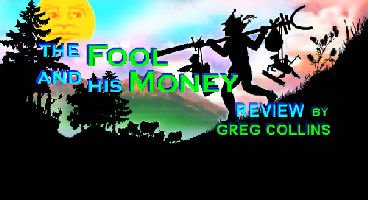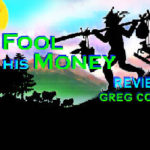
The Fool and His Money






Digital download (about 140 megs)
Platforms: Mac OS 10.4 and up; Windows XP and up
Release date: October 25, 2012
Cliff Johnson’s new puzzle-adventure, The Fool & His Money, is the kind of game that only comes along, well, every twenty-five years or so. It’s a big game. A long game. And, yes, a somewhat expensive game. But it’s also an instant classic. Cliff has done the impossible. A quarter-century after crafting the best game ever made for the original Macintosh, The Fool’s Errand (in glorious 256 grayscale), he’s done it again! The Fool & His Money manages both to be a satisfying sequel to its classic predecessor and a great modern puzzle game in its own right.
In 1987, three years after the debut of the Macintosh, Cliff Johnson released The Fool’s Errand. It was the first of its kind, what became known as a meta-puzzle game. Most puzzle collections are just that. But Fool’s Errand had a complex, encompassing puzzle that required you to finish the main puzzles to confront. This gave the game a fascinating (and deliciously frustrating) added depth. Ten years ago, in 2002, Cliff got the idea to produce a sequel called The Fool & His Money in Director and Flash. Ten years later, on October 25th, he finally released it. (After making his “True Believers” wait a whole decade for the game, it actually came out “early,” beating the official release date by 24 hours.)
The story of The Fool & His Money picks up right where The Fool’s Errand left off. The Fool, after winning the fourteen treasures with the help of the Sun’s Map, is traipsing happily homeward — only to be waylaid by seven pirates. Gone are the treasures and even his knapsack. Also, everyone in Tarot Land seems to be bewitched. They’re all trading in words, gobbling strange herbs, and quaffing even stranger elixirs. The Fool has got now to get to the bottom of this new crisis. With your help, naturally, and with the assistance of the Moon and his map this time around.
As you and the Fool progress from screen to screen solving puzzles, the story, the mystery, and the Moon’s Map slowly fill in. There are four Kingdoms for you to get through — Swords, Wands, Cups and Pentacles. The four kingdoms of the Tarot Card deck itself. There are 70 puzzle screens listed on the main menu. You start off with access to the first of four columns. As you make progress more and more screens become available. But hold onto your Fool’s cap. Soon, you’ll find another area open to you, the Seventh House. This is something of a self-contained game within the game.
Later, when you’ve completed not only the four Tarot realms but the four stages of the seven-room Seventh House, you’ll tackle the Moon’s Map. Good luck. This starts yet another game within the game, only this one is very much connected to the four kingdoms you’ve traveled through. Then, at long last, with every obstacle overcome, you will be treated to the ultimate fate of the Fool in the game’s Finale.
The main menu window, it will slowly dawn on you, serves as the home screen for the Seventh House portion of the game — by entering the seven stained-glass windows of its seven rooms. As you progress through the four stages of the house, the sky and the color scheme will change, growing progressively darker, until you reach night and the hovering blue face of your friend the moon. And this blue moon really does take awhile to come around. Cliff Johnson says the sequel is roughly three times the size of the original. But how you count puzzles depends. If you count simply puzzle “screens,” counting all puzzles in it as one, then the game has about 150. Each puzzle screen, however, may contain as many as a dozen individual puzzles. By my very rough count, I’d say there is somewhere north of 300 individual puzzles in the game.
The game plays out in a modest 800×600 pixel window. But don’t be fooled, this little window contains a very big, very long game. It took me a month to finish. About four times as long as it took me to complete, for instance, The Testament of Sherlock Holmes, itself a fairly long recent adventure.
Is The Fool & His Money an adventure game? Yes and no. Technically, no. But in spirit and in story it plays like one. There’s no inventory, and navigating the game consists of jumping from one self-contained 2D screen to the next. Each screen depicts a different scene from the land of the Tarot, usually with some deranged locals foisting upon you a puzzle or two.
What kind of puzzles? The good kind. Of the few puzzle games that still do come out these days, I can list none that come even close to the cleverness and craftsmanship of Cliff Johnson’s puzzles. There’s a reason why so many True Believers were willing to wait a decade for the game to come out. The puzzles in The Fool & His Money aren’t only fun and challenging, they’re beautifully constructed, and often interconnected with other parts of the game. Also, Johnson is a master at the casually dropped clue. You must read not only the “HELP” for each screen, but the story text that prints out on the “scroll.” Sometimes, you will not solve the puzzle without catching the clues. Further enhancing the puzzle solving is a lot of clever Flash animations and Sound Forge sound effects and open-source music files. Johnson has long been a moviemaker and has a good sense of pacing and of creating dramatic mood with “action” and sound.
Most of the puzzles are word-based. Some look word-based but aren’t. There are lots of other kinds, as well. Like “action” jigsaw puzzles, and numbers puzzles, and graphics action puzzles (i.e., trace the moving line with your mouse). There are Tarot Card games, where you have to beat your opponent at a hand of some strange new card game that only your opponent knows the rules to. Many of the puzzle types reoccur in each of the four kingdoms, but some kingdoms have types exclusive to that land.
Puzzle difficulty? What puzzle difficulty? You like to play puzzles that, what, don’t puzzle you? Actually, I’d say that the level of difficulty overall is similar to the original Fool’s Errand. Some are a piece of cake. Some are heartbreakers. Most are of average difficulty. It’s a good mix, with a breather often showing up just when you really need one. Besides, Cliff’s website offers an extensive, hyperlinked hint/answer pdf file. You can access it at www.thefoolandhismoney.com/07-Hints/index.htm. Or you can download the whole 3 megabyte pdf file and launch it in Adobe Reader. I recommend everyone read the “Foreword.” Cliff gives one of the best rationales for not relying on hints & answers I’ve come across.
This is not a game to rush through. Take your time. Savor. If you’re stuck, give yourself a day or two or even three to mull it over. I got the answer to my own gnarliest puzzle in the shower one morning. I nearly dashed out to my computer and electrocuted myself.
Like the original game, the stylish Tarot Card silhouette artwork is by Brad Parker. Most of the other graphics, it seems, are the result of Cliff discovering Photoshop and Fireworks in a big way. The look of the game really is beautiful, even gem-like in areas. My favorite is the main menu itself and its day-to-night transitions.
Of criticisms, I have only a few. The original game allowed you to save pretty much anywhere you wanted as often as you wanted. The new game has twelve Tarot Card “slots” on its title screen that allow a dozen people to play simultaneously, keeping separate track of each. But you can only save your most recent progress (or not). The game doesn’t autosave but does prompt you when you quit. I had to go into the main folder’s Saved Games folder and manually copy saves and then stow them elsewhere. It works okay but is a bit of a pain. Also, the game’s window (in Windows at least), is neither resizable nor even minimizable.
The game’s manual is essentially strung out from screen to screen in the guise of the HELP button. The author hollers at several points that this is not “Help” but “Instructions.” And indeed it is. Many of the game’s puzzles cannot be understood, much less solved, without recourse to this resource. However, my indigenous aversion to all things labeled “help” kept me from accessing it for at least half the game. Cliff told me he called the button HELP because it was short and pithy. Also misleading. How about INFO instead?
I could have done without the Wager games. I generally like card games. But playing one where only my opponent knows the rules and the only way to learn the game is to get your head handed to you for an hour or so, is not my idea of fun. Why not list the winning combinations someplace?
Finally, let’s face it, The Fool & His Money will set you back a chunk of the latter. At least compared to current industry prices. Having played the game, I can now see why he charges what he does. I doubt there are any six recent puzzle games that combined would equal the length of TF&HM. Still, I worry folks will be scared off by the cost.
You could really grade all commercial games as either “disappointing,” “good” or “better than average.” Only very rarely does a game come out that clearly transcends these categories. Cliff Johnson’s The Fool & His Money is a great game. Puzzle fanatics will be talking about and analyzing it for decades, just as they still do the original Fool’s Errand. I’m happy to award, for the first time in my reviewing career, The Fool & His Money a long-overdue but well-deserved A plus. We, God forbid, may never see another game of its genius and quality in our lifetimes.

Leave a Reply